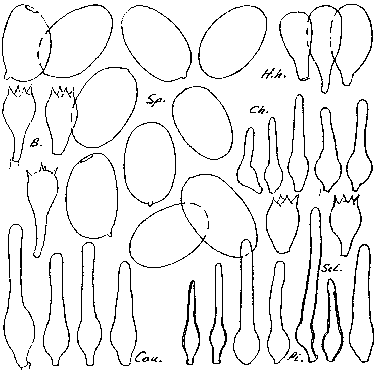Macroscopic features |
Closed pileus up to 4 x 3 mm, at centre brown (K. & W. 7E2, 7D3). Lamellae narrowly adnate, thin, brownish grey (K. & W. 7F2); L= rather few. Stipe 16-18 x 0.5 mm, whitish, somewhat tomentose at base (descr. den Held-Jager). |
Microscopic features |
Spores [20,1,1] 12.6-16.0 x 8.2-9.4 µm, av. L= 13.8, av. B= 8.8 µm, Q= 1.50-1.70, av. Q= 1.60, ellipsoid to ovoid; germ pore distinctly eccentric, c. 2 µm wide. Basidia 4-spored. Pseudoparaphyses not noted. Cheilocystidia 25-40 (-50) x 7-11 µm, lageniform with (sub)cylindrical to slightly tapering neck and 2-4 µm wide apex. Pleurocystidia absent. Pileocystidia 30-70 x 7-12 µm, lageniform with cylindrical to slightly tapering neck and 2-5 µm wide apex. Sclerocystidia sparse. Clamp-connections present. |
Habitat |
On wood-chip at stony road-side with many pieces of wood and stems of flowering plants. Among Campanula, Rhinanthus, Gentiana lutea and Rhododendron. Till now only known from Andorra. |
Remarks |
This species is characterized by large, broad spores in combination with lageniform cheilocystidia and four-spored basidia. Other species that have large spores in combination with lageniform cheilocystidia are C. amphithallus and C. singularis. Both species have 2-spored basidia and in C. amphithallus the spores are distinctly smaller and the pileo- and cheilocystidia are more tapering towards the apex. In C. singularis the germ pore is central and the shape of the spores is different. |

[Copyright © by ]